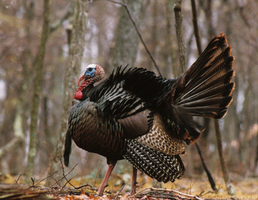 | Back to e-WV
| Back to e-WV
 The West Virginia Encyclopedia
The West Virginia Encyclopedia
 | Back to e-WV
| Back to e-WV
 The West Virginia Encyclopedia
The West Virginia Encyclopedia

The wild turkey is the largest game bird in West Virginia, and it presents one of the greatest challenges to hunters. The bird has vision much better than that of humans, and it is very wary. It is a good barometer to measure our wild lands because it needs not only open areas rich with insects to serve as food for young birds, but also large forested areas with mature food-producing trees such as oaks, beech, and black cherry.
Following the Civil War, the wild turkey population declined drastically due largely to habitat destruction, with the logging of forests and the clearing of land for agriculture. Unlike in many states, however, the wild turkey was not extirpated in West Virginia because some remote habitat survived in the eastern section of the state. Numbers reached a low point in the 1920s. Our forests slowly recovered, but as recently as 1945 there were no more than 6,000 wild turkeys in West Virginia. Most of the state was void of the magnificent bird.
The West Virginia Conservation Commission (now Division of Natural Resources) tried to reintroduce turkeys by rearing them in captivity and releasing them into the wild. This failed, and in 1950 wildlife biologists tried a different and very successful approach, trapping wild birds in the eastern mountains and moving them into other counties. From these core stockings wild turkeys expanded, and today the population has been calculated to be as high as 170,000. The trap and transfer of wild birds was responsible for reestablishing wild turkeys to 39 of our 55 counties. The return of the wild turkey to all counties in West Virginia is considered to be the state’s greatest wildlife management success story.
Written by James C. Pack
Bailey, R. W. & K. T. Rinell. . West Virginia Division of Natural Resources, 1968.
Pack, James C. Life History of the Wild Turkey. Wonderful West Virginia, (Oct. 1994).
Pack, James C. We Did It!. Wonderful West Virginia, (May 1989).